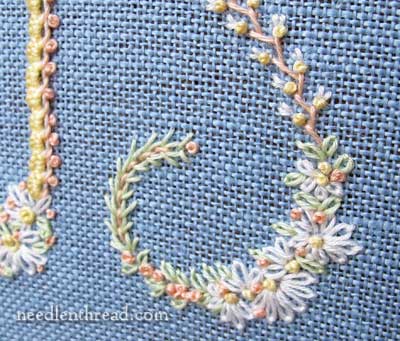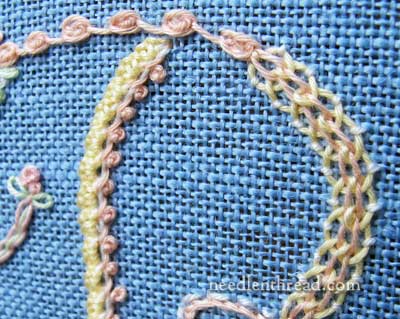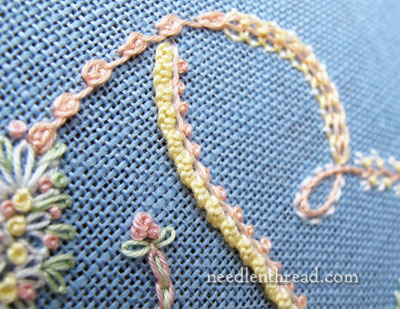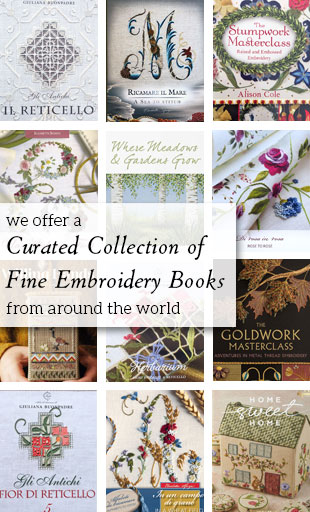An interesting question came up the other day in the inbox, regarding surface embroidery on even-weave linens, or lower thread count linens sold primarily for cross stitch. Essentially, the reader wanted to know “Can it be done?”
To answer the question and make some qualifications, here’s a sneak peek of an upcoming project.

Surface embroidery can be done practically on anything. But when it comes to lower count linens made primarily for the cross stitch market, though you can definitely use them for surface embroidery, there are some considerations to keep in mind in order to achieve really good results with your embroidery.
The above embroidered sample is worked on a linen by Legacy called Atmosphere. (Love the name for the color!) It’s a 30 count linen, and you can see that the threads of the fabric have some separation between them.
This looser spacing between the warp and weft threads of the fabric is the problem spot when it comes to surface embroidery. It can be difficult to get a really smooth line or a smooth edge with surface embroidery when the ground fabric is not a tightly woven, higher thread count fabric.
The sample is stitched with coton a broder 25 and floche. Either one works well on the fabric.

There are a few things you can do to ensure good results with surface embroidery on similar fabrics.
First, there’s the needle consideration. A sharp needle – a crewel (also known as “embroidery”) needle with a sharp tip – is essential.
The reason for this is that you’ll have to split the threads of the linen ground as you stitch. Unlike cross stitch, where a tapestry needle is used precisely so that you don’t split the ground threads, in surface embroidery on this type of fabric, you must split the ground threads or you won’t achieve smooth lines and edges. A tapestry needle is too blunt to split the fabric threads, and will slide off them and slip into the nearest hole between them. This will take the lines or edges of your surface embroidery off course and make things look jagged.

Second, there’s the thread consideration. A single strand of cotton floss does not work as well for surface work on this type of fabric as several strands of cotton or as a heavier, non-divisible thread like coton a broder or floche does. If you are using a single strand, you’ll achieve better results if you have something to help the fabric “grip” the thread….
…which brings us to the third consideration: the possible use of a backing fabric. Especially if you’re working satin stitch or similar filling stitches that require a smooth edge, or if you’re using a single strand of regular cotton embroidery floss, backing the ground fabric with a high count, firmly woven cotton (like muslin or calico) will assure much better results with your surface embroidery.
On the sample above, I used a crewel needle (size 8), coton a broder (and a little bit of floche), and 30 count linen with no backing fabric. And everything worked out pretty well.
And the final difficulty – in fact, it’s probably the thing that bugs me most when using this type of fabric – is the design transfer. It’s frustratingly difficult to draw a clean, accurate line on this type of fabric. The bumpiness of the fabric bumps the pencil off course. The solution? Pull the pencil across the fabric surface at a very low angle to the surface, rather than trying to draw with the pencil upright. If the pencil is upright, the tip catches in the spaces between the fabric threads.
So, moral of the story (was there a story?) is: yes, you can use these types of fabrics for hand embroidery, but there are certain considerations to keep in mind when you do.
Of course, this opens up a Whole New Discussion: not all even-weave fabrics are created equal. But we’ll save that for another day!
If you like the look of Legacy’s atmosphere linen, you can find it at Needle in a Haystack. Just use their search feature in the catalog and type in “atmosphere”. Remember, though, that colors are different on computer monitors. On my computer, the last picture is the best representation of the color.







I was at the store the other day looking for some stitching fabrics. They had packages of “linen”. But when I looked at them, some of the fabric had threads running at an angle. I’m sure it wasn’t cut that way. I think it was just warped. I could name the company but probably shouldn’t.
Where am I going with this? I don’t know. I just know that choosing the right fabric is so important. Watch the threads to make sure they don’t run at an angle and that they’re spaced evenly. I had a friend that (cross) stitched a piece on linen and it turned out tall and skinny instead of balanced because the threads were spaced funny.
One of the things I love about your blog is how creative your use of stitches are. The interlaced chain stitch on the top bulb of the B is beautiful.
I find it really hard to make french knots and the like on evenweave. I always tug a little to hard and the knot ends up at the back of the fabric.
Needs more wraps I guess.
Hi, Julia – if you’re going down in the same hole with the French knot, it’s more likely to pull through. If you make sure to cross over one thread of fabric when you take the needle down, it won’t pull through. Just a thought! – MC
When the embroidery bug first bit me, I didn’t know anything At All about embroidery – the stitches, needles, threads, and…fabric. Not even a stitch dictionary. I saw a beautiful pattern in a French embroidery mag worked in DMC rayon thread for a cushion. Long story short – bought an 11 count (European size) cross stitch fabric, fumbled around with the design and it was nightmarish. Such a waste of beautiful thread, which snagged, raveled, etc. I got 3/4 of the way through the project, though. And my enthusiasm for embroidery was not dampened one whit!
Dear Mary
What lovely stitching love the B monogram and the pretty different pastel threads. thanks for your tips on this post. I can imagine it would be difficult to surface embroider on linen meant for cross stitch, I don’t think I would embroider on this type of linen as I think it would be quite difficult and cumbersome, but an interesting idea though.
Regards Anita Simmance
Looking forward to this project. Is it a monogram class?
Hi, Kathy – Actually…. not really. I am preparing a monogram class, and this type of monogramming will be touched upon in it, but this is a separate entity altogether. It’ll develop a little more over the next couple months. ~MC
Se ve un poco complicado pero esta hermoso ,muy delicado esto hay que hacerlo.Gracias.
I love the delicate, feminine look of these letters. I will definitely watch for posts regarding upcoming alphabet/lettering projects.